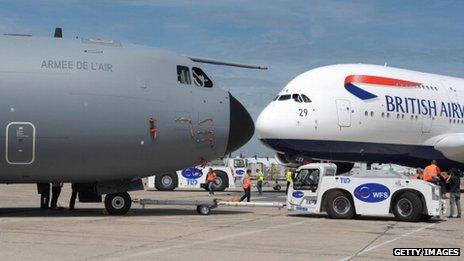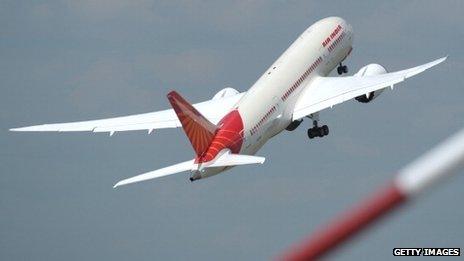Paris Air Show: Tale of confidence and concerns
- Published
Nigel Cassidy reports from the world's largest aerospace event of the year.
The biggest aerospace event of the year takes off in Paris this week with the two sectors that make up the industry in different moods.
On the civil side, aircraft manufacturers are buoyant, with new products to display and a record backlog of orders.
In contrast, the military sector is less confident. Defence budget cuts, particularly in Washington, have meant arms programmes being scaled back or abandoned.
Optimism among commercial aircraft makers was underlined last week when Boeing published its closely-watched annual forecast for aircraft demand over the next 20 years.
The US planemaker estimates that airlines, leasing companies and freight firms will need 35,280 new planes, a rise of 3.8% on the US manufacturer's previous forecast.
The bulk of the demand will come from the Asia-Pacific region as it becomes the biggest travel and tourism market, said Randy Tinseth, vice-president for marketing at Boeing Commercial Airplanes.
"There is no doubt the industry's centre of gravity is moving from the US to Asia. Right now, 37% of all traffic touches Asia," he said. In 20 years, he estimates, that number will be 50%.
The Paris Air Show headlines will be dominated by Boeing, and that other big beast of the industry, Airbus, shouting about how many orders they have won.
It's a fair bet that most of those orders will be placed by Asian and Middle East airlines, with many buying aircraft in the key medium range segment dominated by Boeing's 737 and the Airbus A320.
Big presence
But what could be fascinating about the Paris trade fair is that this market segment is the one where the two manufacturers face the biggest challenge to their duopoly.
China's Commercial Aircraft Corporation, Irkut from Russia, and Canada's Bombardier - with its C-Series close to making its first test flight - are developing aircraft that they hope will take market share.
And all three have a big presence at the show.
Given the ambitions of these companies, and the demand for new aircraft over the next two decades, analysts believe there is space for new entrants.
Says aviation consultant Howard Wheeldon: "The expansion of China, Russia and Japan, along with existing players who may yet have other long-term intentions such as Embraer and Bombardier, may bring closer the day when the current duopoly between Boeing and Airbus is brought into question."
The order books at Boeing and Airbus are bulging with a backlog of some 6,000 aircraft. High fuel costs, requirements for reduced noise, and the need to replace ageing aircraft means there is certainly a market for these challenger planemakers to aim at.
But Wheeldon wonders if this could be as good as it gets. "With analysts now suggesting that the price of oil may have peaked, particularly given the increase in US shale gas production, will some of the urgency to replace older aircraft now disappear?"
Rivalry

Final preparations: Two Airbus planes are moved in to position
This is the 50th aerospace trade fair in Paris since the city hosted its first in 1909. As it is on Airbus's home turf, the company will want to make a big splash. Boeing, therefore, will not want to be upstaged.
One, possibly two, Boeing Dreamliners, will be on display - one making aerial displays and the other on the ground. Boeing wants to ram home the message that the aircraft's troubles of earlier this year are well behind it.
Meanwhile, Airbus, which on Friday made a much-anticipated maiden flight of its A350, may yet get clearance for the new-generation aircraft to make a flypast.
In the battle for the hearts and minds of the world's aviation money-men, such symbolism matters.
New aircraft are prone to delays and technical problems. So proving that your latest product can actually fly is a major milestone, says Nick Cunningham, aviation analyst at Agency Partners.
"It's good news because it means that you've missed an opportunity to have another big delay," he says.
But the pace of growth worries some experts. Problems with large industrial projects like building aircraft are not new.
'Too far, too fast'
But analysts such as Wheeldon wonder if last year's Airbus A380 wing problems, followed by this year's temporary grounding of the Dreamliner are indicative of pressures to use new technologies to reduce weight and improve efficiency.
He says: "Are the technological boundaries that we understand being pushed too far too fast? Indeed, how much room is really left for airline operators to make even more all-important performance gains?" They are questions that need more discussion, he says.
The bragging rights at air shows go to the company that announces the most orders.
At a media briefing on Thursday, EADS chief executive Tom Enders said he hoped the airlines would sign contracts for firm orders and options for "hundreds" of aircraft.
At the Paris show two years ago, Airbus notched up more than 700 orders. Analysts do not expect a repeat of that number.
Boeing, meanwhile, has actually played down expectations that it would notch up a large batch of orders, suggesting that, these days, trade shows carry less importance as occasions to negotiate and network with potential buyers.
Stretched

A Boeing Dreamliner takes part in a practice run
A deliberate lowering of expectations? Or part of the marketing psychology designed to outflank Airbus? We'll know by the end of the week.
One product we may hear a lot about, however, is a "stretched" version of the Dreamliner, so that it can carry more passengers and compete more directly with Airbus's new A350.
Boeing has yet to give the go-ahead for the project, but Singapore Airlines and United Airlines have said they might consider buying a larger Dreamliner.
If Boeing can get a couple of launch customers to commit, Paris would be an ideal time to make the announcement.
The company may also use Paris to officially push the button on a more modern version of its existing 777, using a greater amount of composite materials.
However, Richard Aboulafia, analyst with the Teal Group, is not expecting too much from Boeing at the show.
"Boeing has the broader product line but they are still struggling under the shadows of the 787 (battery) nightmare and they seem unenthusiastic about launching new products."
No-show
On the defence side, Paris may be a lot quieter than normal (except for the fighter jets that scream across the skies during the daily displays).
Lockheed Martin, the world's largest defence company, has a much-reduced presence and will not fly its F-35, a jet regarded as a technological masterpiece.
And Northrop Grumman - whose companies include the builder of the Spirit of St Louis, which made the first solo non-stop New York to Paris flight - is not attending.
US government officials and military top brass will also be in short supply. Money is tight following deep budget cuts. But the lack of the usual strong US presence has surprised some experts, as its defence firms now need exports more than ever.
This may open the door for other countries to better showcase their wares to the 50-plus official government and military delegations due to attend.
Russia will be out in force, displaying attack helicopters and fighter jets, including the Sukhoi Su-35. Embraer will show its Super Tucano combat aircraft, and from Europe the Saab Gripen, Eurofighter Typhoon, and Airbus A400M will make appearances.
But Europe, too, has scaled down its turnout. "Defence is in the doldrums and cuts to the budgets of all European nations will impact on what equipment is shown."
By the end of the week, some lucky companies will have done deals and covered their costs of going to Paris a thousand-fold. Others will wonder why they bothered.
But, says Wheeldon: "For everyone who engages in the world of aviation and whose professional lives are bound up in various forms of aerospace technology, Paris can for one week be the greatest place in the world."